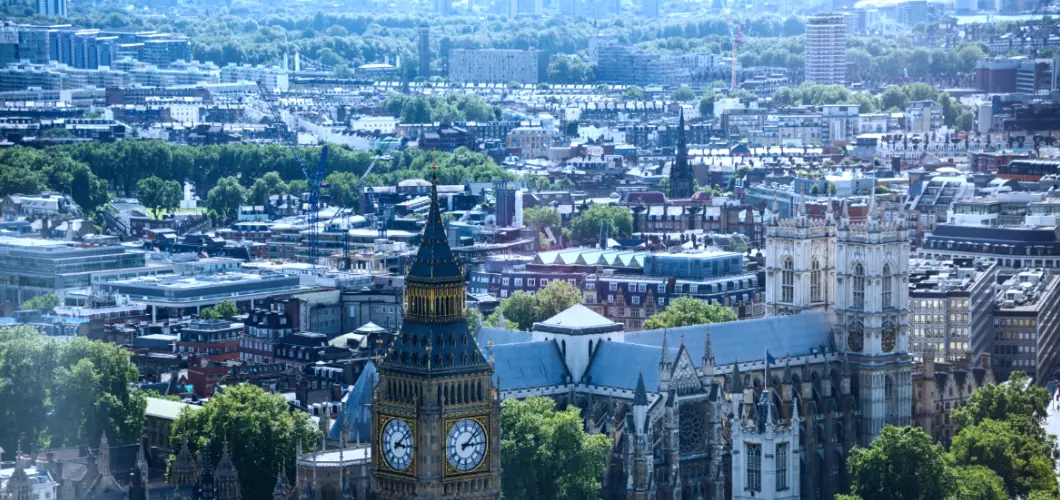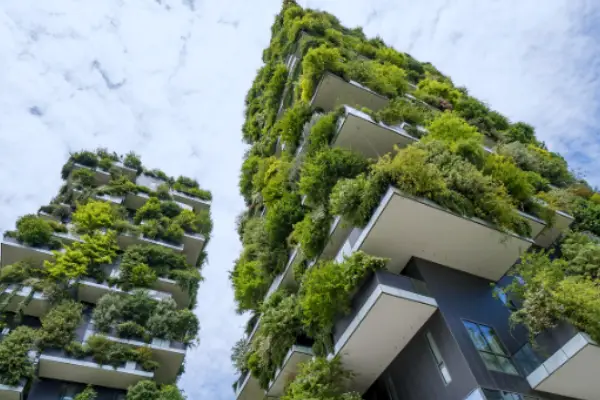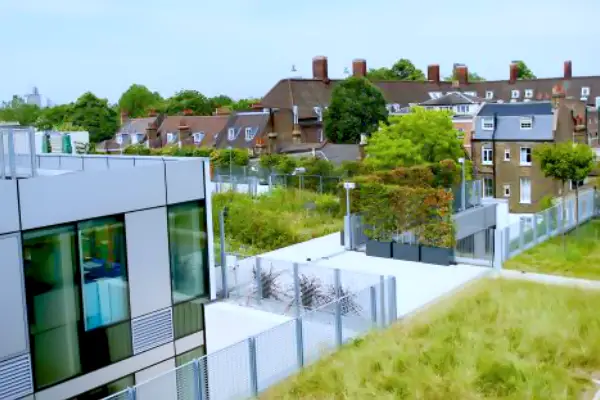
Sustainability in Construction: The UK Perspective
Sustainability in construction has become a pivotal focus in the UK, driven by the urgent need to address climate change, reduce carbon emissions, and enhance resource efficiency. As one of the most significant sectors impacting the environment, the construction industry must adopt sustainable practices to ensure a greener future.
This article explores the current state of sustainable construction in the UK, the strategies being employed, and the benefits and challenges associated with these practices.
The Importance of Sustainability in Construction
The construction industry significantly impacts the environment, contributing to approximately 40% of global CO2 emissions and 30% of raw material consumption (World Economic Forum) (RICS). In the UK, the sector accounts for a substantial portion of the nation’s carbon footprint, making it a critical area for implementing sustainable practices. Sustainable construction aims to minimize environmental impact, enhance energy efficiency, and improve the overall quality of life for future generations.
Find Out If Your Practice Is Sustainable By Discovering Your Digital Growth Score
Key Strategies for Sustainable Construction
1. Energy Efficiency and Renewable Energy
One of the primary strategies for sustainable construction is improving energy efficiency. This involves designing buildings that consume less energy for heating, cooling, lighting, and appliances. The UK government has set ambitious targets to reduce carbon emissions from buildings by 80% by 2050 (World Economic Forum). To achieve this, various measures are being implemented:
- Insulation: Proper insulation reduces the need for heating and cooling, thereby decreasing energy consumption.
- Energy-Efficient Windows: Double or triple-glazed windows help retain heat and reduce energy loss.
- Renewable Energy Sources: Incorporating renewable energy systems such as solar panels, wind turbines, and ground-source heat pumps can significantly reduce a building’s carbon footprint.
2. Sustainable Materials
Using sustainable materials is another crucial aspect of green construction. These materials have a lower environmental impact throughout their lifecycle, from production to disposal. Examples include:
- Recycled Materials: Using recycled steel, concrete, and glass reduces the need for virgin materials and minimizes waste.
- Sustainable Timber: Sourcing timber from responsibly managed forests ensures the preservation of ecosystems and biodiversity.
- Low-Impact Materials: Materials like bamboo and straw bales have lower carbon footprints compared to traditional construction materials.
3. Waste Management
Effective waste management is essential in sustainable construction. The UK construction industry generates significant waste, with much of it ending up in landfills. Strategies to mitigate this include:
- Recycling and Reusing: Materials like concrete, bricks, and metals can be recycled and reused in new projects.
- Prefabrication: Prefabricated components reduce waste on construction sites and enhance efficiency.
- Construction Waste Management Plans: Implementing waste management plans helps track and reduce waste generation throughout the project lifecycle.
4. Water Conservation

Water conservation is a critical component of sustainable construction. Techniques to reduce water usage include:
- Rainwater Harvesting: Collecting and storing rainwater for non-potable uses such as irrigation and toilet flushing.
- Low-Flow Fixtures: Installing low-flow taps, showers, and toilets reduces water consumption.
- Greywater Recycling: Treating and reusing greywater from sinks and showers for landscape irrigation.
5. Green Building Certifications
Green building certifications like BREEAM (Building Research Establishment Environmental Assessment Method) and LEED (Leadership in Energy and Environmental Design) provide frameworks for assessing and improving the sustainability of buildings. These certifications promote best practices in design, construction, and operation, encouraging the industry to adopt higher standards of sustainability.
Optimized Revit Means Fewer Clashes & Fewer Delays. Is Your Revit Optimized?
Benefits of Sustainable Construction

1. Environmental Benefits
The primary benefit of sustainable construction is the significant reduction in environmental impact. By using energy-efficient designs, renewable energy, and sustainable materials, the industry can lower greenhouse gas emissions and conserve natural resources. Additionally, sustainable construction practices help reduce waste and pollution, contributing to a cleaner, healthier environment.
2. Economic Benefits
Sustainable construction can lead to considerable cost savings over the lifecycle of a building. Energy-efficient buildings have lower operating costs due to reduced energy and water consumption. Moreover, sustainable buildings often have higher property values and can attract higher rents and sales prices. The growing demand for green buildings can also create new job opportunities in the construction and renewable energy sectors.
3. Social Benefits
Sustainable buildings provide healthier and more comfortable living and working environments. Improved indoor air quality, natural lighting, and better temperature control contribute to the well-being of occupants. Furthermore, sustainable construction can enhance community resilience by promoting the use of local materials and supporting local economies.
Challenges in Implementing Sustainable Construction
1. High Initial Costs
One of the main challenges of sustainable construction is the high initial investment required. Energy-efficient technologies, renewable energy systems, and sustainable materials can be more expensive upfront compared to conventional alternatives. However, these costs can often be offset by long-term savings in energy and maintenance.
2. Lack of Awareness and Expertise
There is a need for greater awareness and expertise in sustainable construction practices. Many stakeholders in the construction industry, including architects, engineers, and contractors, may lack the necessary knowledge and skills to implement sustainable practices effectively. Ongoing education and training programs are essential to address this gap.
3. Regulatory and Policy Barriers
Regulatory and policy barriers can also hinder the adoption of sustainable construction practices. Building codes and regulations may not always support innovative sustainable technologies and materials. Governments need to provide clear guidelines and incentives to encourage the industry to adopt greener practices.
Emerging Trends in Sustainable Construction
- Smart Buildings and IoT: The integration of Internet of Things (IoT) technologies in construction is paving the way for smarter, more sustainable buildings. Smart sensors and systems can optimize energy use, improve building management, and enhance occupant comfort. For instance, IoT devices can monitor real-time energy consumption and environmental conditions, adjusting heating, cooling, and lighting to improve efficiency (World Economic Forum).
- Circular Economy Principles: The construction industry is increasingly adopting circular economy principles, which focus on minimizing waste and maximizing resource efficiency. This involves designing buildings for disassembly, using recyclable materials, and reusing building components. The aim is to create a closed-loop system where materials are continuously reused, reducing the demand for new resources and minimizing environmental impact (RICS).
- Green Roofs and Walls: Green roofs and walls are becoming popular in urban areas for their environmental and aesthetic benefits. These features help reduce urban heat island effects, improve air quality, and provide additional green spaces in cities. They also enhance building insulation, reducing energy costs for heating and cooling (World Economic Forum).
- Sustainable Urban Planning: Sustainable construction is not limited to individual buildings but extends to entire communities and urban areas. Sustainable urban planning involves designing cities and towns to reduce environmental impact, promote efficient use of resources, and enhance the quality of life for residents. This includes developing green infrastructure, promoting public transportation, and ensuring access to green spaces (World Economic Forum) (RICS).

Government Initiatives and Policies
The UK government has been proactive in promoting sustainable construction through various initiatives and policies:
- The Climate Change Act 2008: This act set legally binding targets to reduce greenhouse gas emissions by at least 80% by 2050 compared to 1990 levels. It provides a framework for building a low-carbon economy and includes measures to promote energy efficiency and the use of renewable energy in construction (RICS).
- Building Regulations: The UK’s building regulations have been updated to include sustainability requirements. Part L of the building regulations, for example, focuses on the conservation of fuel and power, setting standards for the energy performance of new and existing buildings (World Economic Forum).
- Green Deal: The Green Deal was a government initiative aimed at improving the energy efficiency of buildings. It provided financial assistance for energy-saving improvements, allowing property owners to repay the costs through their energy bills. Although the scheme has ended, it highlighted the importance of financial incentives in promoting sustainable construction (World Economic Forum).
- Future Homes Standard: Scheduled for introduction in 2025, the Future Homes Standard aims to ensure that new homes built from 2025 will produce 75-80% less carbon emissions compared to current levels. This standard will require new homes to incorporate low-carbon heating systems and high energy efficiency (World Economic Forum) (World Economic Forum).
The Role of Industry Stakeholders
- Architects and Designers: Architects and designers play a crucial role in sustainable construction by incorporating green principles into their designs. This includes selecting sustainable materials, optimizing energy efficiency, and designing for adaptability and reuse. Architectural practices are increasingly adopting sustainability as a core value, leading to innovative and environmentally friendly building designs (RICS).
- Contractors and Builders: Contractors and builders are essential in implementing sustainable construction practices on-site. This involves using sustainable materials, minimizing waste, and ensuring that construction processes are energy-efficient. Training and education in sustainable practices are vital for these stakeholders to effectively contribute to green construction (World Economic Forum).
- Developers and Investors: Developers and investors have the financial power to drive demand for sustainable buildings. By prioritizing sustainability in their projects and investments, they can influence the construction industry to adopt greener practices. Sustainable buildings often offer long-term financial benefits, including higher property values, reduced operating costs, and increased tenant satisfaction (World Economic Forum).
- Occupants and End-Users: The preferences and behaviours of building occupants and end-users also impact the sustainability of buildings. Awareness and education about sustainable living practices can encourage occupants to use buildings more efficiently, reducing their environmental impact. End-users’ demand for sustainable buildings can drive market trends towards greener construction (RICS).
Future Outlook
The future of sustainable construction in the UK looks promising, with ongoing advancements in technology, increasing regulatory support, and growing market demand. Key areas of focus for the future include:
- Net-Zero Buildings: The push towards net-zero buildings, which produce as much energy as they consume, will continue to gain momentum. This involves integrating renewable energy systems, improving energy efficiency, and using sustainable materials to create buildings that have minimal environmental impact (World Economic Forum).
- Resilient Infrastructure: Climate change resilience will be a critical aspect of future construction projects. Designing buildings and infrastructure that can withstand extreme weather events, rising sea levels, and other climate impacts will be essential for sustainable development (RICS).


2 Responses